You can add more SATA ports to your motherboard using a SATA Expansion Card (SATA Port Multiplier).
It is a PCIe device that connects to a PCIe slot on your motherboard and may feature multiple SATA connectors for attaching your storage devices.
A modern motherboard has multiple SATA ports that connect hard disk drives, solid-state drives, and optical drives to a computer.
While the available 4-6 SATA ports on a typical motherboard are sufficient for most users, there may arise situations where you may need to add even more SATA ports to your computer. In this article, we will extensively look at how to add more SATA ports to the motherboard.
Now there are many different types of SATA expansion cards. Some are large, and some are small. Some have a RAID controller, while others don’t. Here, we will further explore the SATA Port Expansion cards and discuss their essential characteristics.
TABLE OF CONTENTS
So How to Add More SATA Ports to Motherboard?
As mentioned earlier, adding more SATA ports to your motherboard is possible and is done through a port expansion card.
These are readily available, and many are offered for relatively cheap.
Types of SATA Port Expansion Cards and Solutions
The following are different ways to add more SATA Ports to your motherboard. Some methods are cheap, and others are expensive and intended for professionals:
- SATA Hub Port Multiplier
- SATA PCIe Cards
- SAS SATA Expansion Card
We also recommend reading the buyer’s guide below on choosing the expansion card below to understand which one to buy.
1. SATA Hub Port Multiplier (Cheap and Low Performance)
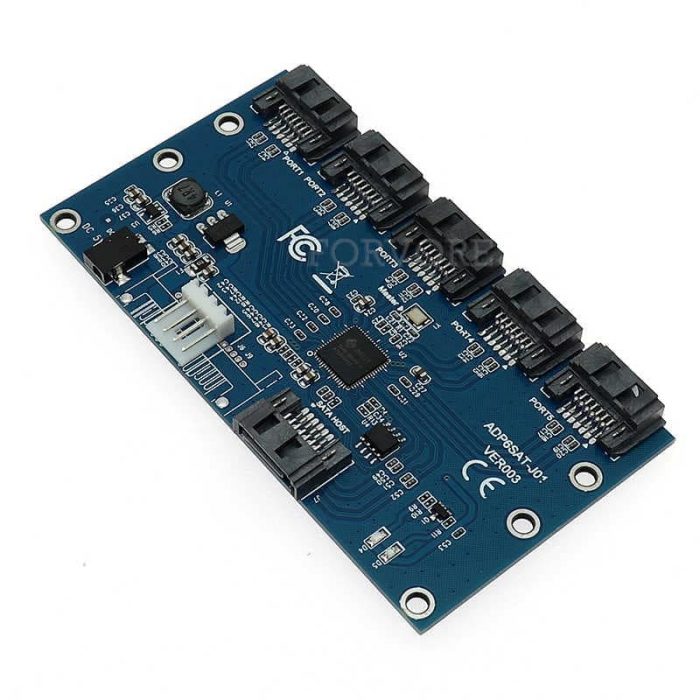
Image: 1 to 5 SATA Port Multiplier
One of the cheapest ways to increase your SATA ports is to use the SATA port multiplier.
This device takes one SATA port and multiplies it into several more.
The issue here is that downstream bandwidth from a single SATA port is not shared effectively and can present a lot of bottlenecks for the connected drives.
While they are cheap, we do not generally recommend these due to performance and compatibility issues.
2. SATA PCIe Cards (Recommended for Most Users)
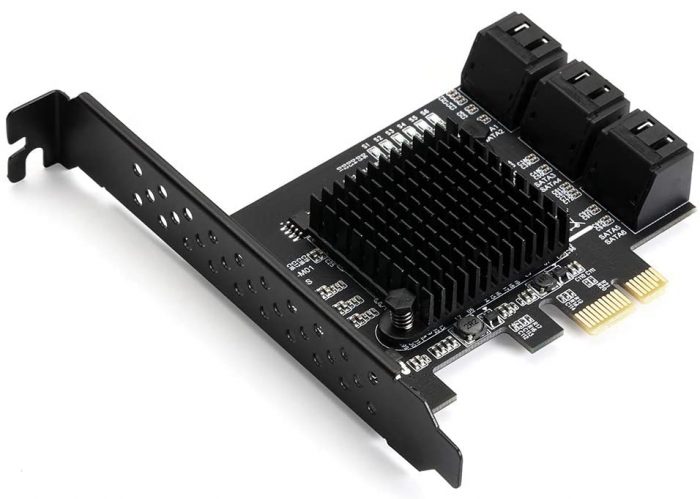
These are your general run-of-the-mill SATA PCIe Expansion cards. When we talk about adding more SATA ports to the motherboard, this is generally the solution we are looking at for an average user.
You can find these in varying sizes and with variable numbers of SATA ports.
You can easily find 2-8 SATA ports on these. However, it is essential to take note of how many PCIe lanes the expansion card utilizes so that you understand the upstream and downstream bandwidth of the expansion card.
I cover this more in the buying guide section below. When buying the right expansion card, you must understand PCIe lanes, version, and throughput rate.
Most of these SATA expansion cards do not feature a RAID controller.
3. SAS SATA Expansion Card (For Professionals)
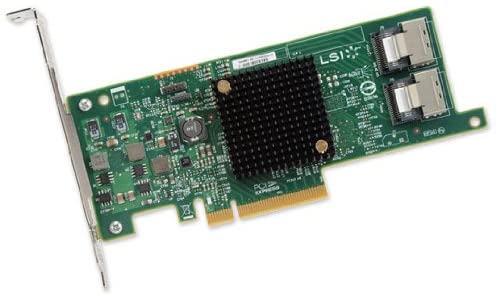
Image: LSI’s PCIe v3.0 x8 SAS SATA Controller
These professional SATA expansion cards have excellent upstream and downstream bandwidth and offer hardware RAID controllers.
These are intended for professional and enterprise use. For NAS users, mainly, these are highly recommended.
These require special cables called SAS to SATA cables. The LSI Logic Controller Card LSI00301 above can support 8 SATA ports. Hence here you will find two SAS-4 SATA ports cables.
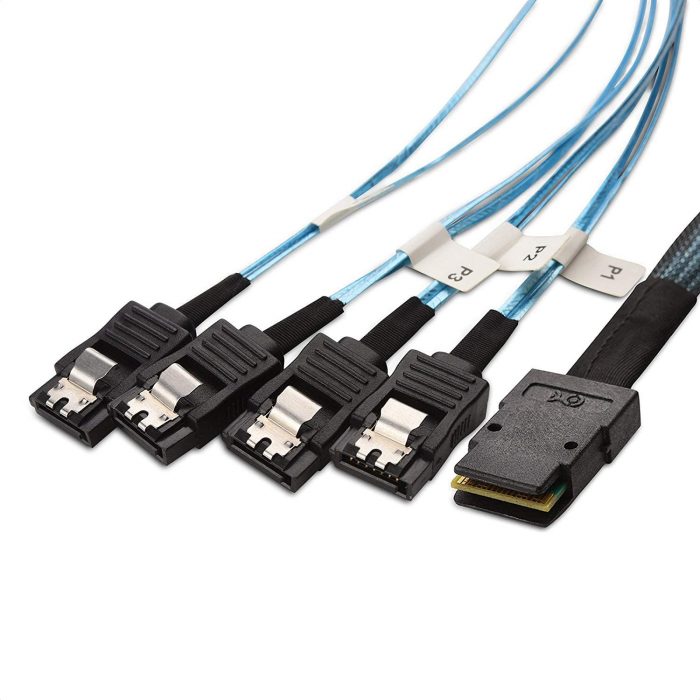
Image: 1-SAS to 4-SATA connectors
Also Read:
SATA Expansion Card Important Characteristics And Features – How to Buy a SATA Expansion Card
Part of knowing how to add more SATA ports to the motherboard is understanding how the SATA expansion cards work. There are a few essential pointers when looking for the right SATA expansion card.
- A version of the SATA Slot
- Amount of Slots it Has
- Size and PCIe Version, i.e., How Many PCIe Lanes they Occupy (Very Important)
- Whether they have a RAID controller
1. Version of The SATA Slot
When looking for a SATA expansion card, make sure that the card offers the latest SATA 3. o ports. It is common to find older SATA 2.0 ports on some older SATA expansion cards.
SATA 3.0 ports have a transfer speed of 6 Gbps (750 MB/s). SATA 2.0, on the other hand, has half the transfer speed of 3 Gbps (375 MB/s).
Also Read: How to Identify SATA 1 2 3 on Your Motherboard and Drive?
2. Amount of Slots it Has
This is a prominent characteristic to look for. You can find SATA expansion cards with 2-8 SATA ports.
When choosing the number of ports, consider the size and the PCIe version of the expansion card to ensure it can deliver decent bandwidth to each slot. We cover this vital point below:
3. Size and PCIe Version, i.e., How Many PCIe Lanes they Occupy (Very Important)
One of the most crucial points to note is the PCIe Connector Size, the amount of PCIe lanes it occupies, and the PCIe version of the expansion card.
SATA expansion cards can have x1, x4, or even x8 connectors. Each number after the ‘x’ generally indicates the amount of PCIe lanes the card will occupy.
So in the case of x1, the card would only occupy a single PCIe lane.
Each lane has a specific throughput rate (transfer speed in layperson’s terms) depending on the version it conforms to. So a single lane on PCIe v2.0 has a throughput of 500 MB/s. However, a single lane on V3.0 has about double the transfer speed of 985 MB/s.
When operating at max speed, a standard hard disk takes up about 200 MB/s. Therefore, if you have a SATA port with only an x1 connector conforming to PCIe v2.0 with four ports, if you have allfour4 drives connected and working at max capacity simultaneously, you will have severe performance bottlenecks.
Let me try to explain with some examples:
Example 1: PCIe v3.0 x1 – 6 SATA Ports Expansion Card
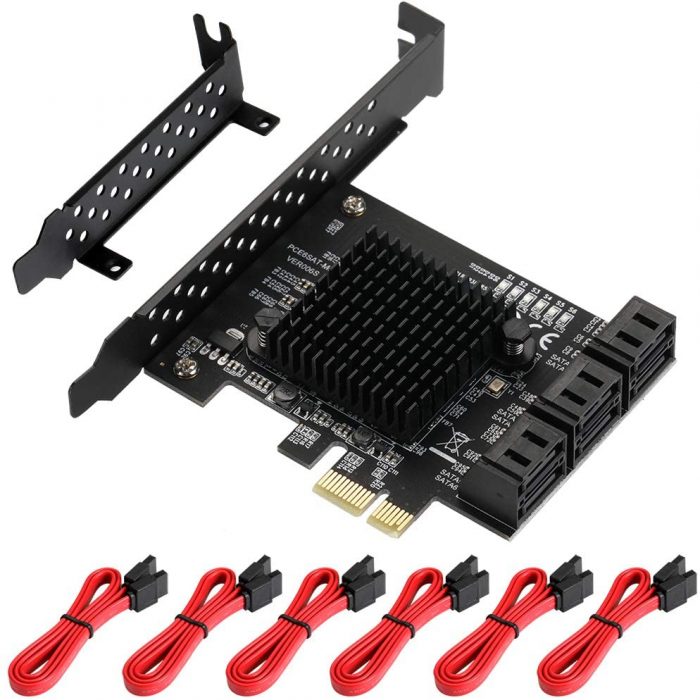
Image: PCI v3.0 six port SATA 3.0 expansion card by MZHOU
Take the SATA expansion card above, for instance.
It uses only an x1 connecter and conforms to the PCIe v3.0 protocol. Hence, it has a maximum throughput of 985 MB/s – the theoretical max throughput of a single PCIe v3.0 lane. In reality, the throughput rate is lower than this. But for simplicity’s sake, we will take 985 MB/s for this example.
Now the Expansion Card has 6 SATA 3.0 ports! So you can connect six hard drives to this. A typical hard disk can occupy 200 MB/s of bandwidth when operating at max capacity.
If you have allsix6 hard disks operating at max capacity simultaneously, you will experience severe bottlenecks, i.e., 200MB/s x 6 = 1200 MB/s when your actual capacity is only 985 MB/s.
This situation would have been even worse had the expansion card conformed to only PCIe v2.0 (500 MB/s per lane).
Primer on PCIe:
Example 2: PCIe v3.0 x4 – 5 SATA Ports Expansion Card
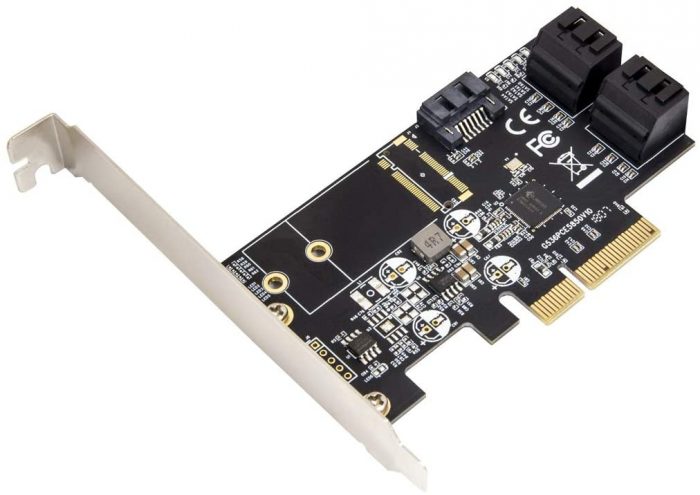
Image: IO CREST PCIe V3.0 (2 PCIe Lanes) – 5 Ports.
This expansion card has an x4 connector but only utilizes 2 PCIe lanes (according to its specifications). Hence given that it conforms to PCIe v3.0, it can reach speeds of about 2000 MB/s (theoretical); 1700 MB/s (typical).
It has double the capacity compared to the previous SATA expansion card. And with a bandwidth of about 1700 MB/s, it should support all five connected hard disks at total capacity without any bottlenecks.
Here you MAY face issues if you connect SATA SSDs to them.
Also Read: What are SATA Ports Used For?
Connecting SATA SSDs to Expansion Card
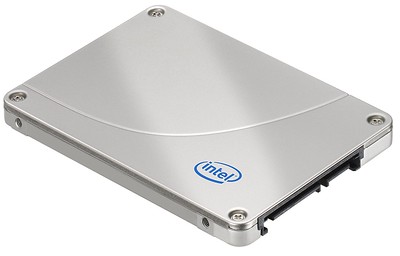
Unlike hard disk drives, SATA SSDs have a transfer speed of about 550 MB/s – more than twice that of a standard hard disk drive.
So when choosing an expansion card, you have to ensure that it can deliver enough bandwidth downstream so that it does not cause any bottlenecks for the SATA SSDs.
For instance, the IO CREST expansion card we saw above was sufficient forfive5 hard disks simultaneously. However, if you were to connect 5 SATA SSD Drives instead, then that would cause bottleneck issues.
Most of the time, the drives DO NOT all run at the same time.
In all reality, most of the time, you do not have to worry much about the bottlenecks if you have all of the ports on the expansion card occupied.
This is because it is doubtful that all the drives will run simultaneously at total bandwidth.
Campaigns run at an idle state until you copy, read, install, or access files from them
3. RAID or Non-RAID SATA Expansion Card
Lastly, the critical consideration when choosing the SATA expansion card is whether it has a built-in hardware RAID controller.
A SATA port expansion card with a RAID controller is more expensive and utilizes more PCIe bandwidth.
NAS builders and professionals generally use these expansion cards.
Also Read:
Conclusion
This article covered different solutions for how to add more SATA ports to the motherboard. Essentially, there are many solutions.
However, you must understand some characteristics regarding how the PCIe expansion cards work before getting the best one.
A SATA expansion card for an average user is not the same as the SATA expansion card for a professional who is building a NAS drive with RAID configuration.
FREQUENTLY ASKED QUESTIONS
1. How do I know if I need more SATA ports?
You may need more SATA ports if you want to connect additional storage devices to your computer, such as hard drives, solid-state drives, or optical drives. If your existing SATA ports are all in use, adding more SATA ports can help you expand your storage capacity.
2. What options are available for adding more SATA ports to my motherboard?
There are several options available for adding more SATA ports to your motherboard. One option is to install a SATA controller card, which is an expansion card that adds additional SATA ports to your system.
Another option is to use a SATA port multiplier, which allows you to connect multiple devices to a single SATA port.
3. What is a SATA controller card, and how can it help me add more SATA ports?
A SATA controller card is an expansion card that can be installed in your computer to add additional SATA ports.
These cards typically connect to a PCI Express slot on your motherboard and can provide several additional SATA ports. SATA controller cards come in different varieties, including those that support SATA 3.0 and SATA 6.0, and some may offer additional features like RAID support.
4. How much does it cost to add more SATA ports to a motherboard?
The cost of adding more SATA ports to your motherboard can vary depending on the method you choose. Installing a SATA controller card can cost anywhere from $20 to $100 or more, depending on the number of additional ports and the features offered. Using a port multiplier is generally less expensive, but may not be suitable for all use cases.
The cost of opening up your computer and adding more SATA ports manually will depend on the availability of spare parts and your level of technical expertise.

This is actually a nice, useful guide. Thank you.
Glad you found this helpful 🙂
I have an expansion card with six SATA ports from PCIe. How do I get my ASUS ProArt Creator Z690 motherboard to recognize the three hard drives attached to the expansion card? Those three hard drives attached to the expansion card do not show up under device manager and I cannot see to assign them letters for each drive, etc.
Thank you. This is very useful information. I’m building a nas for the first time and this helps. 🙂